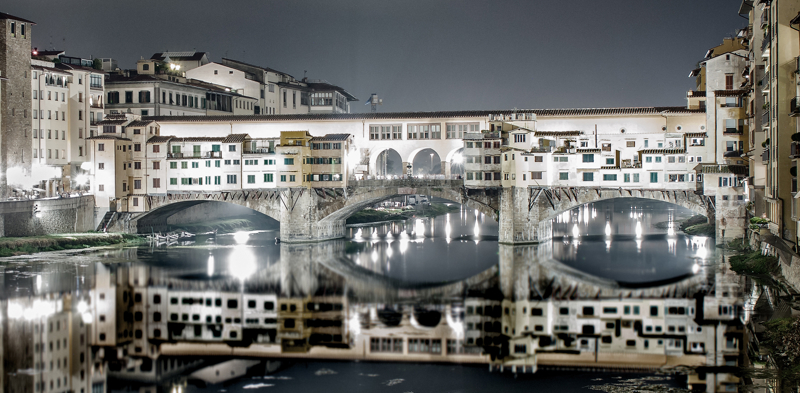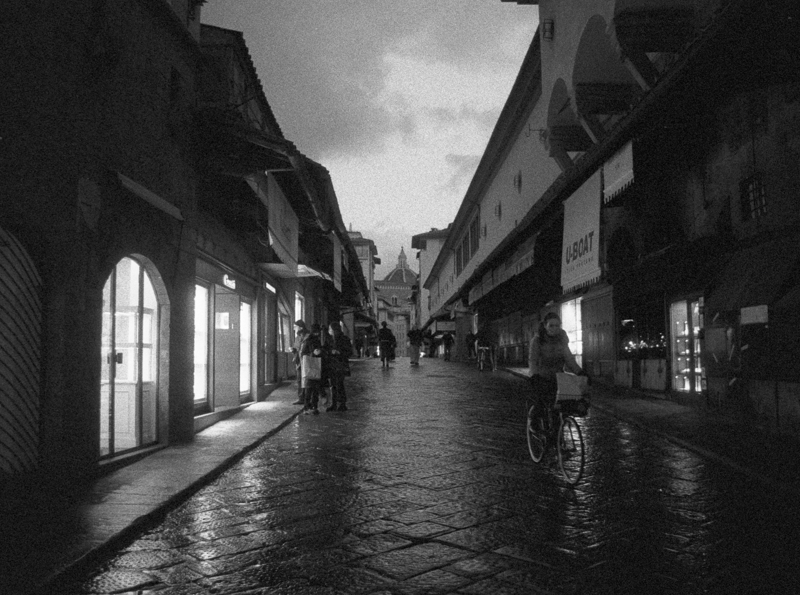Florentine Renaissance
Dear Mom,
I may have said this about the Biblioteca Medicea Laurenziana and the David statue, but this is the most beautiful thing I have ever seen. Imagine looking out into a river, not just any river, but the Arno. The water, beryl blue, your reflection, crystal-clear, and to your left and right the city of Florence. Brunelleschi and Michelangelo, the Medici rule and the Pazzi conspiracy, all for this stretch of land here. If the great flood waters of 1333 didn’t “[sweep] away the defences of the bridge Rubaconte, [overthrow] the castle Altafronte, and [leave] nothing of the old bridge but the two middle piers”,(1) then the Ponte Vecchio wouldn't exist. More than a structure for crossing, more than a platform for observing, this bridge is the culmination of dedication to arts, human nature, and classicism. The floods of September 13th, 1557 “brought down the bridge of the Holy Trinity, two arches of the Carraja bridge, ruined a great part of the Rubaconte”,(2) yet and still, it was the old bridge that remained. The very spot I am standing on is architecturally harmonious. The “dimensions are all multiples of an 8-braccia module…they all form part of the geometric progression 8 to 16 to 32…a ratio of 1 to 2.”(3)
1. Giorgio Vasari, The Lives of the Artists, eds. and trans. Julia Conaway Bondanella, Peter
Bondanella (New York: Oxford University Press, 2008), 224.
2. Vasari, The Lives of the Artists, 224.
3. Theresa Flanigan, "The Ponte Vecchio and the Art of Urban Planning in Late Medieval Florence," Gesta 47, no. 1 (2008): 5, https://doi.org/10.2307/20648957.
Austin Lester
7 chapters
16 Nov 2023
Ponte Vecchio
Florence
Dear Mom,
I may have said this about the Biblioteca Medicea Laurenziana and the David statue, but this is the most beautiful thing I have ever seen. Imagine looking out into a river, not just any river, but the Arno. The water, beryl blue, your reflection, crystal-clear, and to your left and right the city of Florence. Brunelleschi and Michelangelo, the Medici rule and the Pazzi conspiracy, all for this stretch of land here. If the great flood waters of 1333 didn’t “[sweep] away the defences of the bridge Rubaconte, [overthrow] the castle Altafronte, and [leave] nothing of the old bridge but the two middle piers”,(1) then the Ponte Vecchio wouldn't exist. More than a structure for crossing, more than a platform for observing, this bridge is the culmination of dedication to arts, human nature, and classicism. The floods of September 13th, 1557 “brought down the bridge of the Holy Trinity, two arches of the Carraja bridge, ruined a great part of the Rubaconte”,(2) yet and still, it was the old bridge that remained. The very spot I am standing on is architecturally harmonious. The “dimensions are all multiples of an 8-braccia module…they all form part of the geometric progression 8 to 16 to 32…a ratio of 1 to 2.”(3)
1. Giorgio Vasari, The Lives of the Artists, eds. and trans. Julia Conaway Bondanella, Peter
Bondanella (New York: Oxford University Press, 2008), 224.
2. Vasari, The Lives of the Artists, 224.
3. Theresa Flanigan, "The Ponte Vecchio and the Art of Urban Planning in Late Medieval Florence," Gesta 47, no. 1 (2008): 5, https://doi.org/10.2307/20648957.

To the south is the hills, to the north is the plains, and with the Arno below, this bridge is one of the few places in Florence I can get a panoramic view.(4) According to its 1339 commission, beauty along with honor were a requirement, not a subjective quality. The order of the bridge echoes the Florentine government’s ability to place amity and sequence within its public spaces, and subsequently require these traits from its residents.(5) All around, the citizens of Florence go about their day, some merchants and some tradesmen. The “vibrantly colored exteriors, wrought-iron terraces, balconies, and roof gardens”(6) are filled with goldsmiths and jewelers, not butchers and fishmongers, thanks to the decree of Ferdinand I in 1593.(7) Free from a rank stench, their dazzling displays are sold to the many foreigners that flood the street. Behind me is an urban worker with wool all over him. He crosses this bridge on his way home to Oltrarno, a Florence neighborhood.(8) While there is about a 250 year difference, the original design of the Ponte Vecchio remains intact due to legislation passed on March 21, 1346. Such modifications that would detract from the bridge’s decoration like the breaking of exterior walls, the destruction of the bridge’s pavement, and projection of spaces over the river are all prohibited.(9) One of the few things I didn't see is the Medici dukes, as they travel through a walkway above where I am standing to get from the Palazzo Pitti, their home, to the Palazzo Vecchio, a government building.(10) Nevertheless, I am standing on history. History created and credited to the city of Florence. These jewelry exchanges will go on way past me, an ode to the beauty and honor of the city’s rebirth.
4. Flanigan, "The Ponte Vecchio," 9.
5. Flanigan, "The Ponte Vecchio," 9.
6. Flanigan, "The Ponte Vecchio," 5.
7. Flanigan, "The Ponte Vecchio," 6.
8. Flanigan, "The Ponte Vecchio," 1.
9. Flanigan, "The Ponte Vecchio," 12.
10.

Share your travel adventures like this!
Create your own travel blog in one step
Share with friends and family to follow your journey
Easy set up, no technical knowledge needed and unlimited storage!